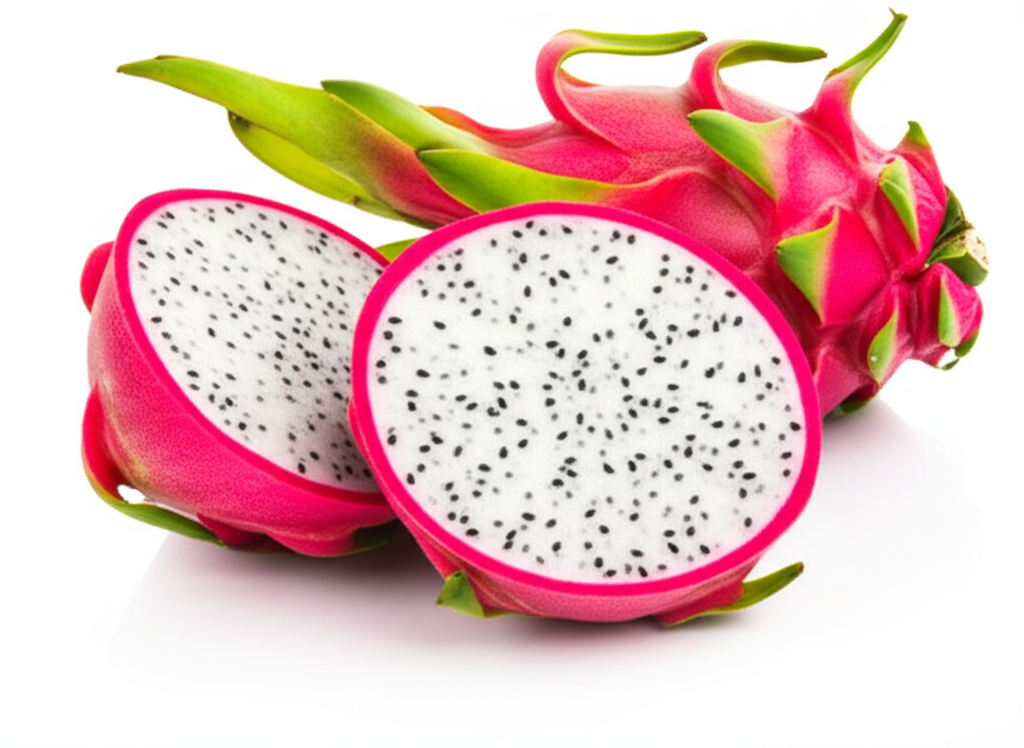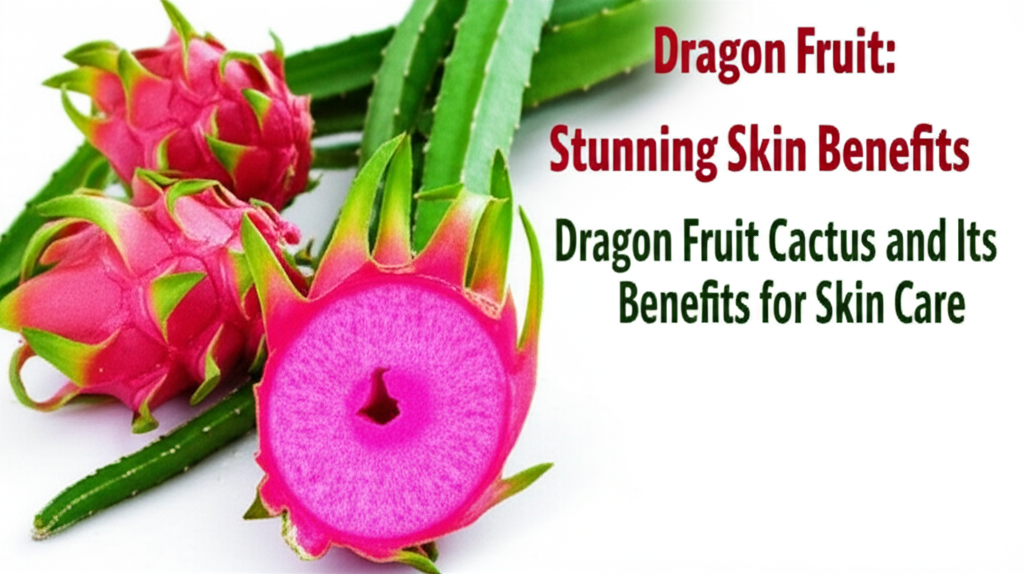Dragon Fruit Cactus and Its Benefits for Skin Care: A Gardener’s Guide to Radiant Results

Can you imagine transforming your garden’s most exotic produce into a luxurious skin treatment? The vibrant, otherworldly dragon fruit, with its striking pink or yellow skin and speckled flesh, is more than just a tropical delight; it’s a powerhouse of nutrients that can work wonders for your complexion. But what exactly makes this unique cactus so beneficial for skin care, and how can you harness its goodness, perhaps even from your own backyard? Understanding the inherent qualities of the dragon fruit cactus allows us to appreciate its potential not just as a delicious fruit, but as a natural ingredient for achieving healthier, more radiant skin.
Quick Answer Box
Dragon fruit cactus, also known as Hylocereus or pitaya, offers significant benefits for skin care due to its rich content of antioxidants, vitamins, and essential fatty acids. These components help to hydrate, protect, and rejuvenate the skin, combating signs of aging and improving overall skin health.
What is Dragon Fruit Cactus and Why It’s Important in Gardening
The dragon fruit cactus, botanically classified as Hylocereus species, is a climbing cactus native to Central and South America. It’s renowned for its large, showy flowers that bloom at night and its distinctive, scaly fruit, commonly called pitaya or dragon fruit. While often grown for its edible fruit, the cactus itself, and particularly its fruit, possesses a remarkable nutritional profile that extends its value into the realm of natural skin care.
In gardening terms, understanding the dragon fruit cactus is crucial for successful cultivation. It thrives in warm climates, prefers well-draining soil, and requires support for its vining stems. However, its importance in skin care stems from its unique biochemical composition. The fruit is packed with Vitamin C, B vitamins, iron, calcium, and most importantly for skin, a wealth of antioxidants like betalains (responsible for the vibrant colors) and flavonoids. These compounds are vital for protecting skin cells from damage caused by free radicals, which are notorious for accelerating the aging process. For gardeners, this translates to appreciating a plant that not only offers a visually stunning addition to the landscape but also provides a potential source for natural, beneficial skin treatments.
Quick Recommendations or Key Insights about Dragon Fruit Cactus for Skin Care
Antioxidant Powerhouse: Dragon fruit is loaded with antioxidants that fight free radical damage, a primary cause of premature aging.
Hydration Hero: The fruit contains a high water content, contributing to skin hydration and plumpness.
Vitamin C Boost: Vitamin C aids in collagen production, essential for skin elasticity and firmness.
Soothing Properties: Certain compounds in dragon fruit can help calm inflamed or irritated skin.
Exfoliation Potential: The tiny edible seeds offer a gentle physical exfoliation when the fruit is used in homemade masks.
Detailed Breakdown of Dragon Fruit Cactus and Its Benefits for Skin Care
Delving deeper into the dragon fruit cactus reveals why this plant is a treasure trove for skin health. Its benefits are multifaceted, touching upon protection, rejuvenation, and overall vitality.
The Science Behind the Glow: Botany and Plant Biology
The dragon fruit cactus, belonging to the Cactaceae family, is adapted to arid and semi-arid environments, storing water in its succulent stems. The fruit itself is a berry, developing from a single flower. The vibrant colors, whether the deep magenta of red dragon fruit or the bright yellow of yellow dragon fruit, are primarily due to betalains. These are potent water-soluble antioxidants that have been shown to possess anti-inflammatory and antioxidant properties, crucial for protecting skin cells from oxidative stress.
Furthermore, dragon fruit is a good source of Vitamin C, a vital nutrient for skin. Vitamin C is a potent antioxidant that plays a critical role in collagen synthesis. Collagen is the structural protein that gives skin its firmness, elasticity, and youthful appearance. As we age, collagen production naturally declines, leading to wrinkles and sagging. By supporting collagen synthesis, Vitamin C helps to maintain skin’s resilience and reduce the visible signs of aging.
The fruit also contains essential fatty acids, particularly linoleic acid, found in the tiny black seeds. These fatty acids are crucial for maintaining the skin’s natural barrier function, which helps to lock in moisture and protect the skin from environmental aggressors. A compromised skin barrier can lead to dryness, irritation, and increased susceptibility to damage.
Practical Applications in the Garden for Skin Care
For the home gardener, the most direct way to leverage the dragon fruit cactus for skin care is by utilizing the fruit itself.
1. Fresh Fruit Masks: The most straightforward application is to mash ripe dragon fruit (either flesh and juice or the whole fruit, depending on desired texture) and apply it as a face mask. The natural sugars in the fruit can provide a mild humectant effect, drawing moisture to the skin.
2. Seed Exfoliation: The tiny, edible black seeds within the fruit can act as a gentle physical exfoliant. When incorporating the fruit into a mask, leaving the seeds in can provide a mild scrubbing action to remove dead skin cells, revealing brighter skin underneath.
3. Juice for Toning: Dragon fruit juice, strained from the pulp, can be used as a natural toner. Its hydrating properties and antioxidant content can help refresh and protect the skin after cleansing.
4. Infused Oils (Advanced): For a more advanced approach, the dried seeds of the dragon fruit could potentially be infused into carrier oils. While research on this specific application is limited, the theory is that the beneficial compounds might be extracted into the oil, creating a nourishing facial oil. However, this requires careful research into safe extraction methods.
Common Mistakes to Avoid
Using Unripe Fruit: Unripe dragon fruit can be tart and may not offer the full spectrum of beneficial compounds. Always use ripe, firm fruit for the best results.
Allergic Reactions: While rare, some individuals might be sensitive to certain components of the dragon fruit. It’s always wise to perform a patch test on a small area of skin before applying any homemade concoction to your face.
Over-Exfoliation: Even the gentle seeds can cause irritation if used too frequently or with too much pressure. Limit exfoliation to once or twice a week.
Not Storing Properly: If you’re using the fruit from your garden, consume it fresh or store it appropriately to maintain its nutritional integrity. Refrigeration is key.
Ignoring Sun Protection: While dragon fruit offers antioxidant protection, it does not replace the need for daily sunscreen. Antioxidants work from within the skin cells, while sunscreen provides a crucial external barrier against UV damage.
Expert Tips or Pro Insights
Combine with Other Natural Ingredients: For enhanced benefits, consider mixing dragon fruit pulp with other skin-loving ingredients like yogurt (for lactic acid exfoliation and probiotics), honey (for its antibacterial and humectant properties), or avocado (for healthy fats and deep hydration).
Chill Your Mask: Applying a chilled dragon fruit mask can have an added benefit of constricting blood vessels, which can temporarily reduce puffiness and redness.
Focus on the Core Benefits: Remember that the primary skin benefits of dragon fruit come from its antioxidants and hydrating properties. Don’t expect drastic, immediate results like those from high-potency chemical treatments. Natural remedies work by supporting skin health over time.
Seed Variety Matters: Red dragon fruit typically contains more betalains than white dragon fruit, potentially offering stronger antioxidant benefits for the skin.
Consider the Source: If growing your own, ensure your plants are healthy and free from pests or diseases. If purchasing, opt for organic, ripe fruits to maximize nutrient content and minimize exposure to pesticides.
Seasonal or Climate Considerations
Dragon fruit cacti are tropical to subtropical plants, meaning they thrive in warm climates.
Growing Season: The fruiting season for dragon fruit typically occurs during the warmer months, often from late spring through summer and into early autumn. This aligns perfectly with when many people seek refreshing and hydrating skincare solutions.
Climate Impact on Fruit Quality: In regions with consistent warmth and ample sunlight, the fruit is likely to develop a richer nutrient profile and more vibrant color. Extreme heat or drought stress without adequate watering can affect the fruit’s quality and sugar content, potentially impacting its skincare efficacy.
Harvesting for Skin Care: For the best skincare benefits, harvest the fruit when it is fully ripe. This is usually indicated by vibrant skin color, slight softening of the fruit, and the small wings on the fruit drying out.
Buying Guide or Decision-Making Process
If you don’t have your own dragon fruit cactus, you’ll likely be buying the fruit. Here’s what to look for:
Appearance: Look for fruit with smooth, vibrant skin. The scales should be evenly colored and plump. Avoid fruit with bruised, shriveled, or moldy spots.
Firmness: The fruit should yield slightly to gentle pressure, similar to a ripe avocado or kiwi. It should not be mushy or rock hard.
Color: The skin color should be deep and uniform for its variety (bright pink or vibrant yellow).
Origin: If possible, opt for organically grown dragon fruit to ensure it’s free from pesticides, which you wouldn’t want on your skin.
* Storage: Once purchased, store dragon fruit in the refrigerator. It can typically last for 1-2 weeks when stored properly.
FAQ Section for Dragon Fruit Cactus and Its Benefits for Skin Care
Q1: Can I use the dragon fruit cactus skin on my face?
A1: While the skin is visually striking, it’s generally too tough and fibrous to be used directly as a facial mask. The primary beneficial components are found in the fleshy pulp and juice of the fruit.
Q2: How often should I use a dragon fruit mask?
A2: For most skin types, using a dragon fruit mask once or twice a week is sufficient. Listen to your skin; if you experience any irritation, reduce the frequency or discontinue use.
Q3: Can dragon fruit help with acne?
A3: The antioxidants and Vitamin C in dragon fruit can help reduce inflammation, which may indirectly benefit acne-prone skin. Its hydrating properties can also help balance oil production. However, it’s not a primary treatment for severe acne.
Q4: Is dragon fruit suitable for all skin types?
A4: Generally, yes. Its hydrating and antioxidant properties are beneficial for most skin types. However, as with any new ingredient, a patch test is recommended, especially for those with very sensitive or reactive skin.
Q5: Can I freeze dragon fruit for later use in skincare?
A5: Yes, you can freeze dragon fruit pulp. Once thawed, it can still be used in masks, though the texture might be slightly softer. Freezing helps preserve its nutrients for longer.
Conclusion for Dragon Fruit Cactus and Its Benefits for Skin Care
The dragon fruit cactus offers a fascinating duality: a visually stunning garden specimen and a source of potent natural skincare ingredients. By understanding the science behind its vibrant flesh, you can unlock its potential to hydrate, protect, and rejuvenate your skin. Whether you cultivate your own pitaya or simply seek out this exotic fruit at the market, incorporating it into your routine can be a delightful step towards achieving a healthier, more radiant complexion, naturally. Embrace the glow of the dragon fruit and let its tropical goodness nurture your skin from the inside out.


